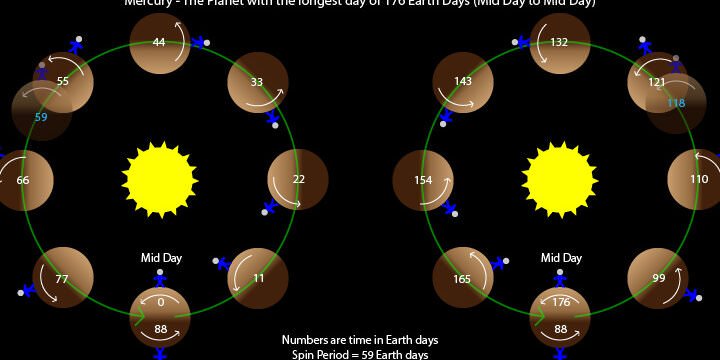We are accustomed to the notion that a day, or 24 hours, is the standard duration, and a year consists of 365 days. This is our familiar order of time, and we often forget that it does not apply universally. Specifically, this is only true for Earth. Other celestial bodies have their own unique rhythms. It is quite intriguing to explore the length of a day on different planets. Let’s delve into this topic in more detail.
When referring to a day, we are not only considering the period of daylight, as commonly understood – the cycle of day and night. In a broader sense, a day typically signifies a span of twenty-four hours, as we say “5 days have passed” or “there are 30 days in a month,” implying a complete day.
On the contrary, a solar day represents the time it takes for a planet to complete one full rotation on its axis. A year, on the other hand, encompasses a complete orbit around the Sun.
A day on Mercury
Mercury, the planet closest to the Sun, has an elliptical orbit rather than a strictly circular one. It can come as close as 46 million kilometers to the Sun and move as far as nearly 70 million kilometers away.
Mercury completes a full revolution around the Sun in 88 Earth days, which is equivalent to a year on Mercury. However, its rotation around its axis takes only 58.65 Earth days, making a full day on Mercury shorter. Interestingly, if we consider the full rotation relative to the stars, Mercury has a sidereal day.
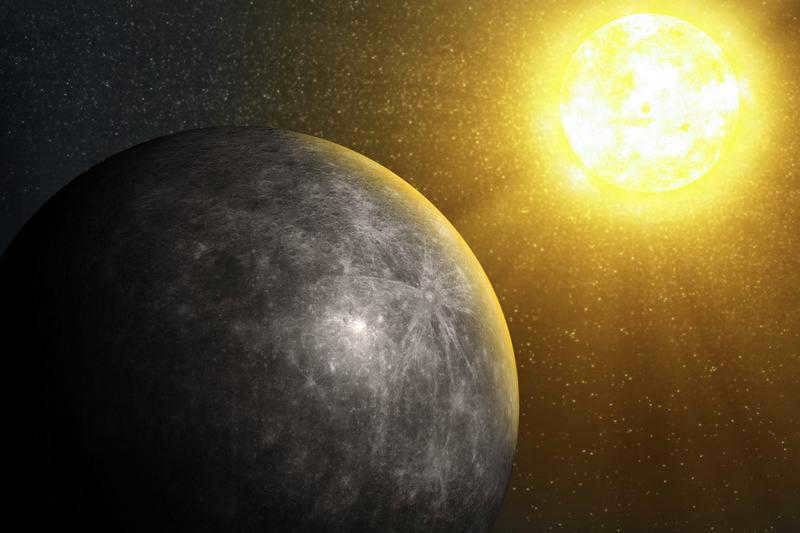
However, the duration of a day on Mercury is quite unique – it lasts for 176 Earth days. This is the amount of time it takes for the planet to complete one full rotation, from dawn to dawn. The reason for this is Mercury’s close proximity to the Sun, which causes it to move at a high speed while rotating at a slower pace due to the solar tidal influence. As a result, a couple of local years pass during the span of a single day on Mercury.
Mercury’s day length is truly exceptional within the solar system, primarily due to its close proximity to the Sun. Additionally, the planet’s inclination results in perpetual darkness at its north pole, where water ice is even believed to exist in the craters. This is because the Sun never reaches that area, preventing the surface from being heated.
A Day on Venus
Venus, the second planet in the solar system and our closest neighbor, was once believed to be Earth’s twin. Science fiction writer Robert Sheckley has written numerous engaging stories about venturing to Venus. However, as scientists discovered the hellish conditions that prevail on the planet, opinions drastically shifted.
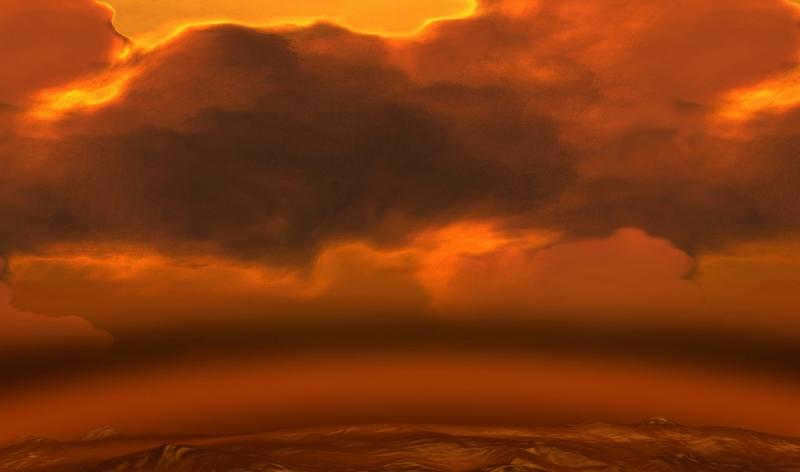
Venus experiences a rather cloudy day, unlike any other planet.
Venus takes 224.7 Earth days to complete one orbit around the Sun, which is equivalent to a year. However, this planet rotates at a very slow pace and in the opposite direction compared to other planets. A full day on Venus lasts for 243 Earth days, which is longer than its local year!
Interestingly, a solar day on Venus lasts only 116.8 Earth days, which is the time from one sunrise to the next. This is because Venus rotates in the direction of the Sun, and when combined with its orbital motion, it results in Venusians being able to witness two sunrises and sunsets in a single day. They could even celebrate New Year’s twice in a day if they were there, provided the thick Venusian cloud cover didn’t obstruct their view.
A unique phenomenon on Venus is the duration of a day, which would pose challenges for Earthlings to adapt to.
A day on Mars
Mars, the fourth planet in our solar system and our neighbor, is further from the Sun compared to Earth. However, the concept of a day on Mars is relatively “decent” and familiar. Mars completes one rotation around its axis in approximately 24 hours, 37 minutes, and 23 seconds, which is similar to our Earth. Therefore, one could say that a day on Mars is comparable to ours.


A day on Mars is approximately equivalent to a day on Earth.
By the way, a Martian day is known as a sol. One sol equals one Earth day, almost, although there is still a 37-minute discrepancy, which becomes quite noticeable over longer periods of time. For two days, the difference will be over an hour, and for a week, it will be more than 4 hours.
However, the Martian year is almost twice as long as the Earth year, lasting 686.98 of our days. This is not surprising, considering that Mars is farther from the Sun, and its orbit is much longer.
Jupiter, the gas giant and the fifth planet in the solar system, lacks a solid surface, resulting in an uneven rotation. At latitudes near the poles, a day lasts for 9 hours, 55 minutes, and 40 seconds, while at the equator, it is 5 minutes shorter. Jupiter’s rotation is akin to that of a liquid body. Despite its massive size, the planet spins like a wolf, with the start of a new day on Jupiter coinciding with the passage of our third day.

The duration of a year on Jupiter is quite different from that on Earth – it takes about 11.86 Earth years for Jupiter to complete one orbit around the Sun. However, due to its significantly larger distance from the Sun (about 5 times greater than Earth’s), this disparity is not surprising. During one full Jupiterian year, an observer on Jupiter, positioned high in the clouds, would witness more than 10476 sunrises and sunsets. This is precisely the number of Jupiterian days contained within a Jupiterian year at mid-latitudes.
A day on Saturn
Saturn, known as the ruler of the rings, is the sixth planet in our solar system. It is classified as a gas giant, similar to its neighbor Jupiter. Saturn shares the characteristic of rotating at incredibly fast speeds, completing a full revolution in just 10 hours and 33 minutes. This is half the length of a day on Earth.
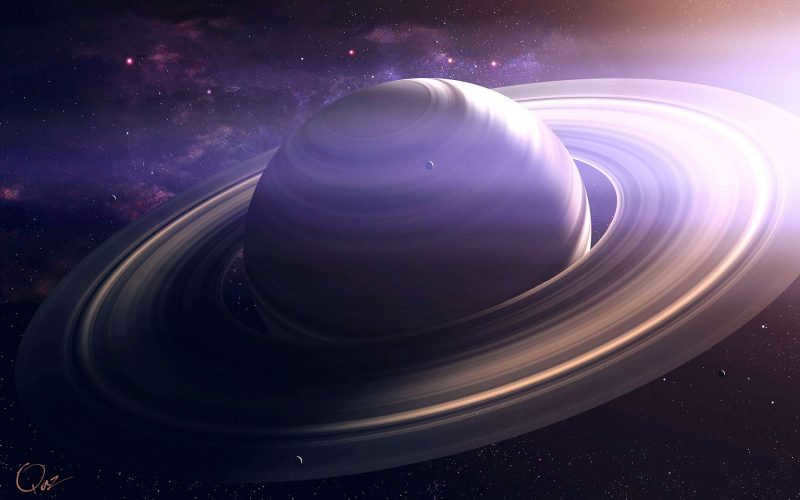
Once again, Saturn is classified as a gas giant, and its rotational speed varies across different latitudes. As a result, the length of a day on Saturn is approximately 5 minutes shorter at the equator compared to the poles. It’s worth noting that on such celestial bodies, not only the rotational speed differs at various latitudes, but also at varying depths. Consequently, scientists utilize multiple systems for time measurement on these planets.
The orbital period of Saturn, or the time it takes to complete one revolution around the Sun, is a lengthy 29.45 Earth years. This extended duration is primarily due to the fact that Saturn’s average distance from the Sun is approximately 9.5 times greater than that of Earth.
A day on Uranus
Uranus, another gas giant, is the seventh planet in our solar system, although it is smaller in size compared to the preceding planets.
Being 19 times farther away from the Sun than Earth, a year on Uranus lasts 89 Earth years. This means that while a year is passing on Uranus, an entire generation of people is being born and dying on Earth! Since its discovery in 1781, 238 years have elapsed, and Uranus has only completed its third revolution around the Sun…
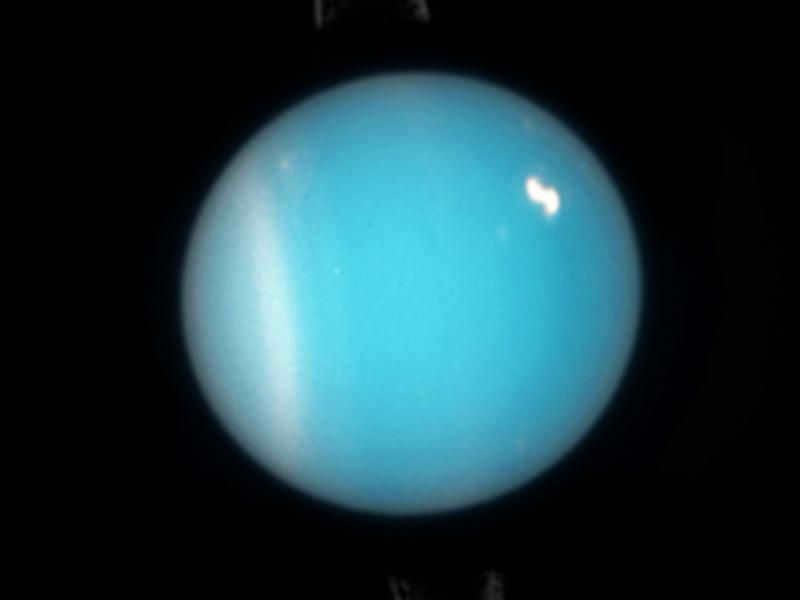
A photo of Uranus is displayed. The rings surrounding the planet are visible.
Understanding the duration of a day on Uranus poses significant challenges. This is due to the peculiar orientation of the planet, as it “tilts on its side” while other planets “stand” with a slight inclination. If we consider their orientation relative to the plane of the ecliptic – their orbits – Uranus rolls on its side within its orbit, resulting in its days and seasons behaving unlike those of other planets.
Technically, Uranus completes one full rotation around its axis in 17 hours and 14 minutes, which can be considered the length of a day. However, if we examine the concept of a day in the traditional sense, it becomes much more complex than that.
Interesting phenomena occur on Uranus during its local year, as the planet is oriented differently towards the Sun compared to other planets. For a continuous period of 42 Earth years, one pole experiences constant sunlight without sunset, while the other pole experiences the same duration of sunlight. This results in a prolonged polar day and summer, followed by an equally long polar night and winter. Meanwhile, at the equator, the Sun barely rises above the horizon, similar to our northern regions.
During the equinox, the Sun reaches its zenith at the equator, bringing about a balance between day and night as expected. Subsequently, the planet gradually rotates to position the next pole towards the Sun, leading to “polar nights” at the equator and a 42-year day at the pole. Meanwhile, the other pole experiences a 42-year night during this time.
Strictly speaking, if we choose a specific point at the pole, a complete day from sunrise to another sunrise will be equivalent to a year, which is 89 Earth years. However, the situation is quite different at the equator – there the day only lasts for 17 hours, although the length of the night varies. Not only that, but Uranus is a gas giant, and its uppermost layers rotate even faster, completing a revolution around the axis in just 14 hours.
Therefore, the concept of daytime on Uranus is quite peculiar, depending on one’s perspective and location. If we were present there and able to live for at least one Uranian year, we would witness some incredibly strange phenomena during that time. All of this is due to the planet’s significant tilt, as 97 degrees is no laughing matter.
A Day on Neptune
Neptune, the final gas giant, offers a more straightforward experience compared to Uranus. Its orbit around the Sun takes approximately 164.79 Earth years. The planet was initially detected in 1846, and it wasn’t until 2011 that it finished its first revolution, embarking on its second local year since its discovery.
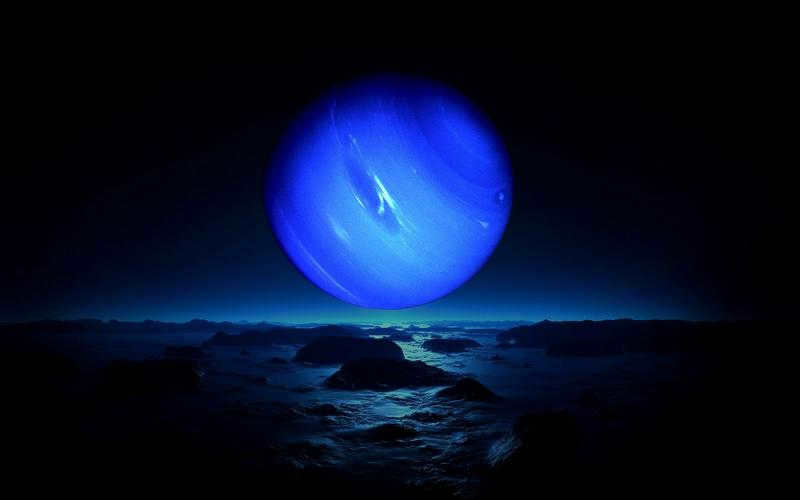
This is an example of what Neptune could potentially appear like as observed from Triton’s moon.
However, the duration of a day on Neptune, similar to other gas planets, is not as straightforward. The length of a day at the equator is 18 hours, while at higher latitudes it is 16 hours, and at the poles it is 12 hours. This phenomenon is responsible for the incredibly strong winds found on Neptune, which can reach speeds of up to 2100 km/h. In fact, the wind on Neptune is nearly twice as fast as the speed of sound in regular air!
Mercury is often described as the most enigmatic and extraordinary planet in our solar system. It can be seen in the sky only during the early morning and right after sunset, and it is the closest planet to the Sun. Additionally, Mercury has a faster rotation around the Sun compared to other planets, and a single day on Mercury lasts for 58 Earth days.
Key facts about Mercury
Mercury was first observed by Assyrian astronomers in the 14th century BC and was referred to as a “bouncing planet”. The ancient Romans named it after the swift-footed god of commerce and wealth due to its rapid movement. Galileo Galilei further examined the planet using a telescope, and today, scientists employ radar and radio astronomy techniques for their studies. In 1974, the Mariner 10 spacecraft made three close passes by Mercury, significantly expanding our understanding of this celestial body.
Despite being part of our solar system, Mercury remains a planet that is not extensively studied. It has a radius measuring 2,440 kilometers and a density slightly lower than that of Earth. The temperature on its surface can reach a scorching +349.9°C during the day and plummet to a freezing -170°C at night.
Mercury possesses an extremely thin atmosphere, primarily composed of oxygen, hydrogen, and helium atoms.
However, the combination of the planet’s low mass and intense solar winds prevent its atmosphere from staying intact around the celestial body, despite the relatively high daily surface temperature.
Some notable characteristics of Mercury include the absence of a satellite and the presence of a tail-like formation, giving it a comet-like appearance. This tail extends over 2 million kilometers in length.
Images taken in 1974 provide an insight into the structure of Mercury’s surface. The planetary terrain bears a striking resemblance to the lunar landscape, featuring mountains, valleys, plains, as well as both ancient and recent craters. The largest plain, known as Zhara, originated within a crater with a towering peak exceeding 2 km. Zhara stretches 1530 km in length and spans 1320 km in width.
Scientists propose that the formation of Mercury’s surface occurred in distinct stages. Following the planet’s formation, it endured multiple asteroid impacts, resulting in the creation of craters.
Subsequently, volcanic activity commenced on the celestial body, giving rise to lava plains on its surface. The solidified lava formed distinct undulations and folds that bear a resemblance to the ebbing and flowing of ocean waves.
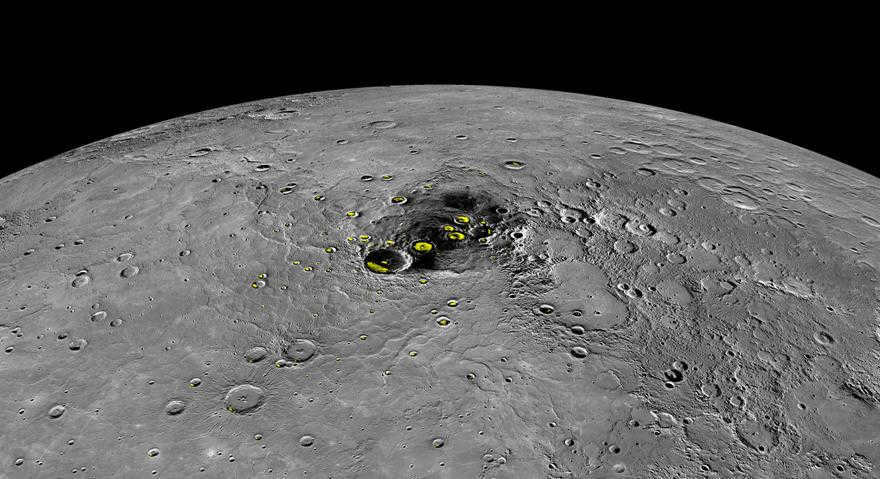
However, the landscape of Mercury still possesses distinctive characteristics and intricate details.
- Long depressions with flat bottoms, known as grabens;
- Ledges that resemble impressively sized blades, known as escarpments.
Mercury’s core is remarkably massive, constituting approximately 82% of the celestial body’s total mass. It is believed to exist in a liquid state and serves as the origin of a relatively weak magnetic field.
Orbit and orbital period
Mercury’s path around the Sun is highly elongated, taking the planet as close as 46 million km and as far as 70 million km. This eccentric orbit results in drastic temperature fluctuations on the planet’s surface. Unlike Earth, Mercury’s axis of rotation is perpendicular to its orbit, so it does not experience seasons or weather changes. Furthermore, there are regions on the planet that have never been exposed to sunlight, leading scientists to speculate that there may be ice present.
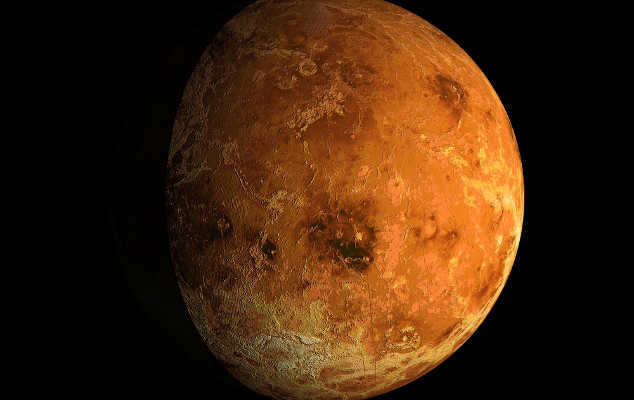
For quite some time, scientists were confident that Mercury perpetually presents the same face to the Sun, resulting in intense heating from the Sun’s rays, due to the synchronization of its rotational period and its orbit around the Sun. This peculiar phenomenon is exclusive to Mercury within the Solar System.
A Unique Aspect of Mercury’s Rotation
Mercury, the closest planet to the Sun, has a unique rotation pattern that results in an intriguing phenomenon. While it takes 88 Earth days for Mercury to complete a revolution around the Sun, it only takes 58 Earth days for the planet to rotate once on its axis. As a result, a year on Mercury lasts approximately 1.5 of its own days.
A Double Sunrise and Double Sunset
One fascinating consequence of Mercury’s rotation is the occurrence of two sunrises and two sunsets during a single Mercurian day. As the Sun moves across the sky of Mercury, it reaches a point where it appears to stop and then reverses its direction. This unique movement is caused by the specific characteristics of the Sun’s rotation around its own axis. As a result, at longitudes 90° from the meridians, both sunrise and sunset are observed twice in a day.
Mercury is a unique planet in the Universe. Its proximity to the sun makes it stand out. Despite being the closest planet to the Sun, it is not the hottest. A day on Mercury lasts about 58 days, 15 hours, and 30 minutes. Unlike other planets, Mercury has a very thin or almost non-existent atmosphere. The temperature on Mercury can vary greatly, ranging from hot to cold.
The temperature on Mercury can fluctuate depending on various factors, making it extremely hot or cold at times. The planet Mercury takes about 88 days to complete one orbit around the Sun. The days and nights on Mercury are unlike any other planet. Its slow rotation contributes to longer days.
Put simply, if you find yourself on the planetary surface (specifically Mercury), it will require a considerable amount of time (176 Earth days) before you can witness the majestic dawn.

What is the duration of a day on Mercury?
| Days on Mercury | Day duration on Mercury |
| 1 day | 58.646 Earth days |
| 2 days | 117.292 Earth days |
Mercury has unique orbits in comparison to other planets in the solar system. The duration of Mercury’s orbital period is not constant or stable due to its position in the orbit. When Mercury is closer to the Sun, its velocity increases, while the velocity decreases when the planet is farther away from the Sun.
The period of time it takes for Mercury to complete a full orbit around the Sun is approximately 88 days. Many astronauts hold the belief that Mercury is in close proximity to the Sun and is connected to it in some way. Astronomers also suggest that the Earth and the Moon are closely intertwined. In comparison to Mercury, the days on Earth would be relatively shorter. According to scientific data, one day on Mercury lasts for 58 Earth days.
A solar day on Mercury would be around 176 days in duration. This is due to the planet’s slow sidereal rotation and its high orbital velocity. The cycle of night and day on Mercury may vary in the polar regions. These polar regions, which contain craters, remain in a constant state of darkness.
Other articles you may enjoy:
The temperatures in this area will be cool. The bright radar images are captured from this location on Mercury. Numerous scientists and astronauts have speculated that this could potentially indicate the presence of water (ice) in that area. Compared to Earth, the days on Mercury are significantly longer. The rotation speed of Mercury is incredibly slow in comparison to Earth’s rotation speed.
This variance greatly contributes to the significant length of Mercury’s days.
Mercury lacks typical weather phenomena like clouds, wind, and rain. The rotational speed and climate conditions on Mercury are significantly distinct. The rotation of Mercury is slow, resulting in longer days compared to Earth.
Mercury experiences extremely long days, as it takes more time to complete one revolution around the sun compared to Earth. When Mercury is closer to the sun, its days are quite hot, while its nights are relatively cool with lower temperatures. The day and night cycles on Mercury are peculiar and unique.
Due to numerous differences, one cannot expect the length of days on Mercury to be the same as on Earth. The atmospheric conditions on Mercury are unstable, which may explain the absence of life on the planet.
Summary
Mercury is an ancient planet in our solar system that offers a unique perspective on the sun. Its proximity to the sun is extremely close, making it the closest planet to the sun. Additionally, the length of a day on Mercury is longer than that of Earth, with each day taking approximately 1407.5 hours to complete.
Suggestions
I have invested a significant amount of time and energy into crafting this blog post in order to offer you valuable information. It would greatly benefit me if you could contemplate sharing it on social media or with your acquaintances. Spread the love ♥️
We are accustomed to a 24-hour day, but on other heavenly bodies within our solar system, the duration of a full rotation on its axis varies significantly.
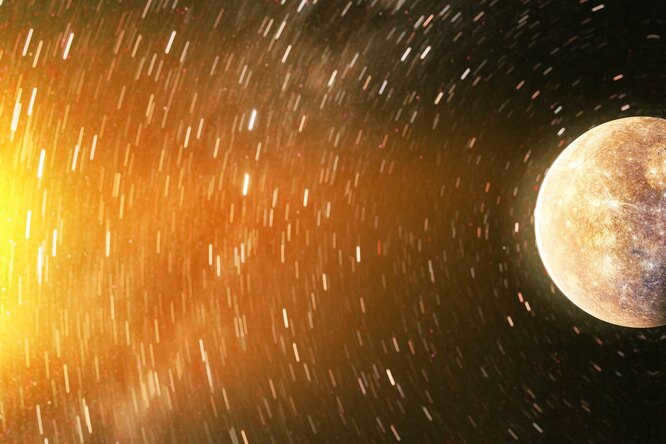
The duration of a day on a particular planet is determined by its rotational velocity, while the length of a year is influenced by its distance from the Sun. Below, you will find the durations of both days and years on each planet within our solar system.
On our home planet, Earth, a day lasts approximately 24 hours (or more precisely, 23 hours and 56 minutes). This is referred to as a sideric day, which represents the time required for a planet to complete a full revolution around its own axis. The remaining planets in our solar system also undergo rotation on their respective axes, and as a result, the lengths of their days can vary significantly.
Mercury
Mercury is the planet closest to the Sun and has a rotational period of 58.6 Earth days. Due to its proximity to the Sun, a year on Mercury lasts only 88 Earth days.
Venus
If one were to reside on Venus, their day would span nearly 243 days (or 5832 hours). An intriguing fact about Venus is that its year consists of 225 days, making a day on Venus longer than a year. Additionally, Venus rotates in the opposite direction to Earth, resulting in the Sun rising in the west and setting in the east.
Mars
Mars is often referred to as our planet’s twin, with a day length that is similar to Earth’s at 24 hours and 37 minutes. However, Mars is located further away from the Sun, resulting in a longer year that lasts 687 Earth days.
Jupiter
This massive gas giant exhibits a unique rotation rate, varying between its equatorial region and poles. The cloud belts at the equator complete a full revolution in 9 hours and 56 minutes, while at the poles, the revolution time is slightly quicker at 9 hours and 50 minutes. The accepted length of a day on Jupiter is determined by its magnetic field and is approximately 9 hours and 55 minutes. Additionally, a year on Jupiter is equivalent to around 4333 Earth days, which is roughly 12 Earth years.
Saturn
Saturn is a gas giant with varying rotational speeds across its different regions. However, researchers have determined the official length of a day on Saturn to be 10 hours and 33 minutes. A single year on Saturn is equivalent to approximately 10,759 Earth days, which is roughly equivalent to 29 years on our planet.
Uranus
Uranus completes one full rotation on its axis every 17 hours and 14 minutes. However, the duration of a year on Uranus is much longer, lasting for 30,687 days, which is equivalent to 84 Earth years. Similar to Venus, Uranus exhibits retrograde rotation, meaning it spins in the opposite direction compared to Earth.
Neptune
Living on Neptune would entail experiencing a day that lasts approximately 16 hours, while a year would span 60,190 days. This indicates that a single year on Neptune is equivalent to 164.8 Earth years.
TechInsider Network Edition
Founder of “Fashion Press” LLC: 119435, Moscow, Bolshoi Savvinsky per. 12, str. 6, floor 3, room II;
Address of the editorial office: 119435, Moscow, Bolshoi Savvinsky per. 12, p. 6, str. 6, floor 3, room II; Editorial office address: 119435, Moscow, Bolshoi Savvinsky per. 6, floor 3, room II;
Chief Editor: Nikita Vasilenok
Email address of the editorial office: [email protected]
Phone number of the editorial office: +7 (495) 252-09-99
Label for information product: 16+
The network edition is registered with the Federal Service for Supervision in the Sphere of Communications, Information Technologies and Mass Media, registration number and date of decision on registration: series EL No. FS 77 – 84123 dated November 09, 2022.
The initial planet of the solar system possesses a variety of characteristics:
- It is situated in close proximity to the Sun;
- It has a relatively low mass;
- It possesses a magnetic field;
- It follows an irregular elliptical orbit;
- It resides in a region teeming with celestial bodies.
These and various other factors contribute to the unique climate of Mercury, which we will delve into in the following discourse.
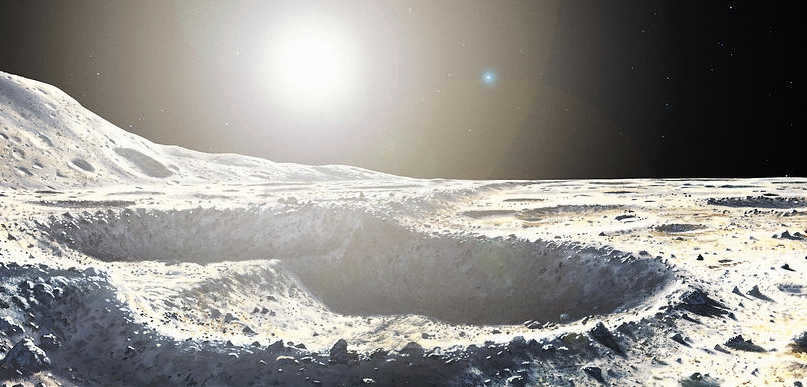

Mercury’s Climate
Scientists theorize that Mercury lost its original atmosphere during its formation approximately 4.6 billion years ago. The current atmospheric layer is replenished through the capture and retention of matter released during collisions with meteorites, space dust, and solar wind. The atmosphere surrounding Mercury is relatively sparse, resembling a vacuum, and is unable to evenly distribute heat across the entire planet. Consequently, the climate on Mercury is heavily influenced by solar activity.
Mercury’s Atmosphere
Mercury, being the smallest planet in the solar system, has the least dense atmosphere. This can be attributed to its low mass. Additionally, the proximity of the planet to the Sun plays a significant role in the composition of its atmosphere. With temperatures reaching several hundred degrees, the elements, including metals, vaporize and contribute to the thinning of the gas shell. The solar wind also plays a role in depleting the atmosphere.
Below is a summary of the chemical composition of Mercury’s atmosphere.
| Chemical component | Content, in % |
| Oxygen, O2 | 40-42 |
| Sodium, Na | 29-31 |
| Hydrogen, H2 | 21-22 |
| Helium, Ne | 6-7 |
| Potassium, K | 0,5-1 |
| Krypton, Kr | 0,09 |
| Methane, CH4 | 0,3 |
| Water vapor, H2O | 0,11 |
| NO, Ar, CO2, N2, Xe, Ne, Ca, Mg | about 0.1 |
The brown color of Mercury’s atmosphere is caused by the abundance of dust and it is divided into four layers:
- The lower layer is heated up to 210 °C and this temperature is maintained by the planet’s thermal radiation and scattered dust.
- The middle part consists of a moving gas mass that resembles the wind on Earth.
- The upper layer extends up to 200 km from the planet’s surface and is extremely hot.
- The exosphere of Mercury’s atmosphere has no defined boundary and seamlessly transitions into the cosmic vacuum.
Temperature Conditions on the Planet
Despite being in close proximity to its star, Mercury does not have the highest temperature in the solar system. Due to its weak atmosphere and low heat capacity, the planet’s temperature experiences significant variations throughout its day.
| Region of the Planet | Average Temperature, °C | Maximum/Minimum Temperature, °C |
| Daytime | +349 | +427 |
| Nighttime | -170 | -183 |
Organic Matter and Frozen Water
Mercury’s axial tilt is minimal, resulting in the Sun’s rays hitting the poles at a near-horizontal angle. As a result, the surface temperature in this zone remains consistently cold at -190°C. Within these polar regions, there are craters that contain frozen water. The estimated amount of ice reserves in these craters is around 1 trillion tons.
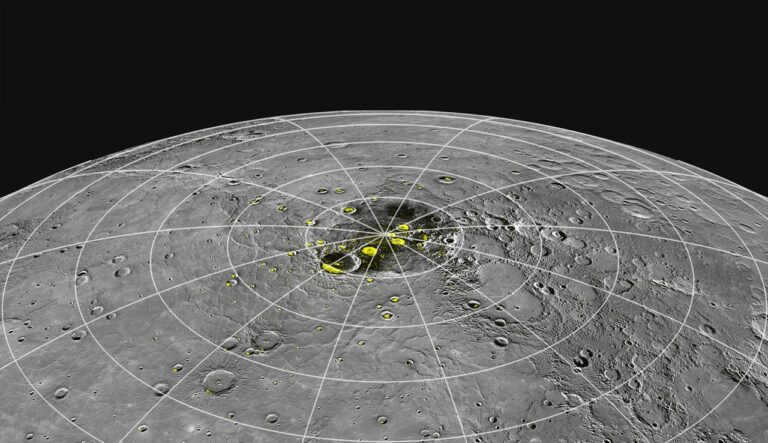
In regions with higher temperatures, accumulations of unidentified material have been discovered, which has a spectral signature indicating it originates from living organisms. Another interesting finding is the presence of methane (CH4) in the planet’s atmosphere. Given the unstable nature of this gas under the extreme conditions found on the closest planet to the Sun, there must be a continuous source. Scientists propose that active hydrogen geysers within the planet could be responsible for the production of methane and water. Alternatively, it is also possible that comets and asteroids deliver organic compounds and ice to Mercury.
Solar radiation, atmospheric characteristics, and the geologic topography are responsible for the unique climate of Mercury.
Mercury’s Lack of Seasons
Unlike Earth, Mercury does not experience the typical changing seasons. This can be attributed to the fact that Mercury’s axis of rotation is almost perpendicular to its orbit plane. As a result, the side facing the Sun becomes extremely hot, while the shadow side remains freezing cold. Essentially, Mercury only has two “seasons”: daytime summer and nighttime winter.
Mercury’s Rotation and Revolution
The rotation of Mercury around its axis takes approximately 56 Earth days, which is equivalent to one day on Mercury. Interestingly, a day on Mercury is twice as long as a year on the planet. This means that day and night on Mercury last for about 176 Earth days, while Mercury completes one orbit around the Sun in just 88 days.
During 8 days each year, an intriguing phenomenon occurs on the surface of Mercury: the Sun appears to move sideways in the sky. This optical illusion causes Mercury to follow an irregular path along its orbit. As a result, the planet experiences a unique event known as a double sunset, where the Sun sets, briefly reappears above the horizon, and then sets again. A similar situation occurs at dawn as well.
Water on the Earth
Despite the extreme conditions on Mercury such as high temperature, thin atmosphere, and weak gravitational force, water is still present on the planet. Spectrometry data reveals that water exists in small amounts in the atmosphere. Although there is ice at the poles, it is not a significant source of water vapor as it is shielded from the sun’s rays in craters. Scientists believe that the water in the atmosphere is formed when space ice gets trapped and is attracted by the strong gravity of the sun.
Asteroid Collisions and Volcanic Eruptions on Mercury
The unique landscape of Mercury was shaped during the initial 700-800 million years following the birth of our solar system. A series of impactful collisions with asteroids and other celestial bodies resulted in the formation of numerous craters across the planet’s surface. While some of these craters have remained untouched, others have been transformed by the powerful forces of volcanic activity, as molten lava filled their once empty cavities.
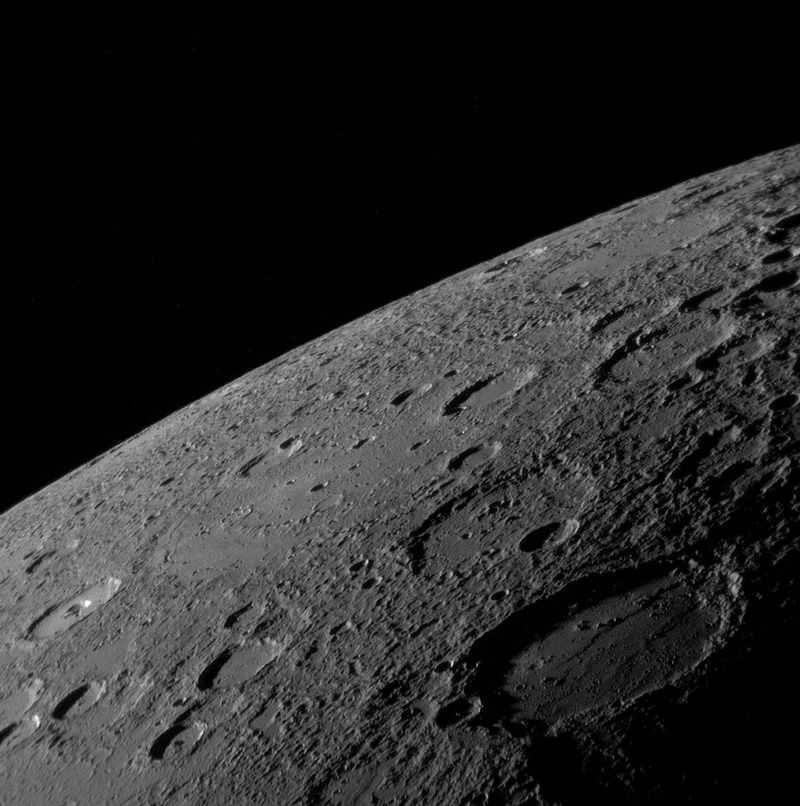
As the crust of Mercury thickened, the frequency of eruptions decreased and eventually stopped completely. The planet’s cooling caused a decrease in its overall volume, resulting in the cracking of the crust and the shifting of its layers to create extended protrusions. This geological process was accompanied by intense earthquakes. Around 3.8 billion years ago, a combination of asteroid impacts and volcanic activity shaped the relief of Mercury. Since then, the planet’s surface has only been altered by collisions with celestial bodies.
- The planet possesses a feeble magnetic field, which reflects the solar wind. However, at the southern pole, there exists an abnormality that allows the Sun’s rays to penetrate the surface and raise its temperature.
- Ancient civilizations could only observe Mercury when the Sun was not present – in the morning prior to sunrise and in the evening after sunset. As a result, they believed that these were two separate celestial bodies.
- As a result of the sparse atmosphere, the Sun will appear white when observed from Mercury.
- Mercury possesses an atmospheric “tail” primarily composed of sodium, measuring a staggering 2.5 million km in length.
- The largest crater on Mercury, known as the Caloris Basin, boasts a diameter of 1550 km. The impact from a meteorite that caused its formation led to an elevation on the opposite side of the planet.

